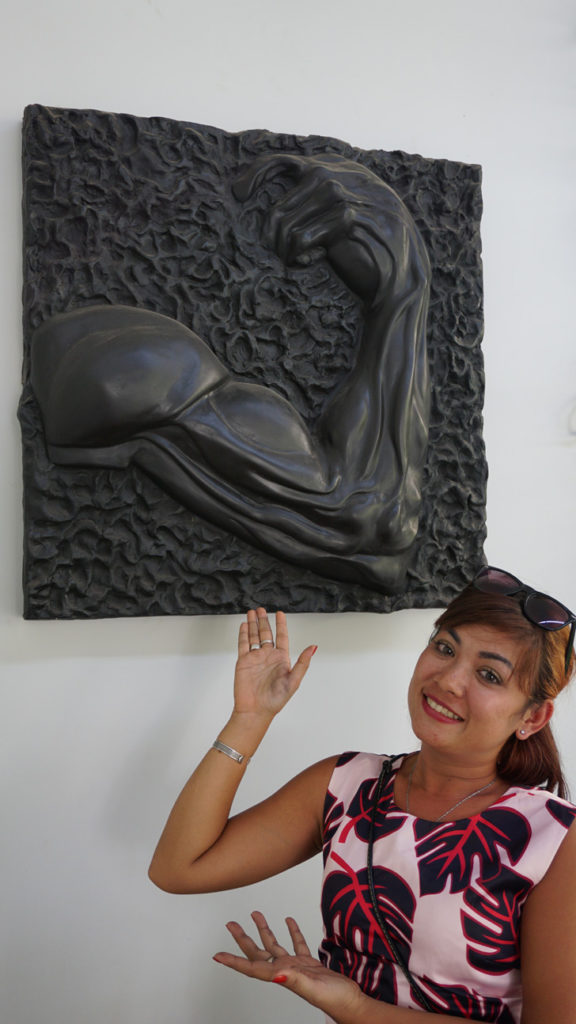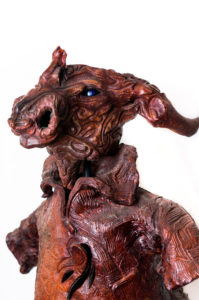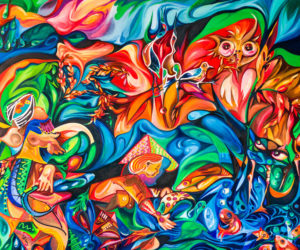 South East Asia Globe Magazine – Culture & Life | By: Daniel Besant
South East Asia Globe Magazine – Culture & Life | By: Daniel Besant
Chhan Dina’s sculptures and abstract paintings have been exhibited around the world and she’s blazing a trail for Cambodia’s artists, particularly women. She was recently named as one of four Cambodian artists to join this year’s Cambodian Living Arts Fellows Programme, which aims to nurture talent and leadership in the Kingdom’s arts community
How would you describe yourself to someone who doesn’t know you?
I am a Khmer sculptor and painter. Hopefully you’ll recognise my unique artwork from various exhibitions around Southeast Asia and further afield. I eat, sleep and breath art.
You spent some of your early childhood in a refugee camp on the Thai border. Can you tell us about your early life and what led you on the path to becoming an artist?
Although I was born in Phnom Penh, my family was forced out of the capital to a refugee camp in Poipet. Life for everybody in Poipet was constantly risky, largely due to vast amount of land mines scattered around the province. I remember walking to school on tiny tracks between fields that were littered with warning signs about buried explosives. We would frequently hear explosions. Children, farmers, cows, dogs would perish by accidentally straying into a restricted area. Luckily when I was nine my family returned to Phnom Penh. I met Mr Ron, an American artist that lived nearby. He saw me playing with dirt and modelling figures from clay. He shared sculpting techniques with me and taught me how to sketch. He encouraged me a lot.
Who are the artists that have inspired you the most and why did they inspire you?
I am heavily influenced by everyday life and activities. I collect fine art books at every opportunity, I have an expanding library, from Matisse, Rothko, Van Gogh, Constable to Escher.
Many of the great artists were so poor, they created because of their love of art. I love expressing myself though colour and shapes. Creativity before money!

What inspires you to create?
I’m inspired by the world around me. I regularly visit the provinces to observe farmers, boat builders, the markets. I love nature, I love animals and the environment. I hope I can bring important environmental issues to peoples minds.
I am also inspired and encouraged by other artists. I’ve visited Beijing, Dublin, London, Bangkok, I spend countless hours and days in every kind of gallery and art shop.
What is the reaction from ordinary Cambodians when you tell them you are an artist?
Some are very supportive and encouraging. Many are indifferent. They find it difficult to relate to my abstract works. If subjects in my creations are not instantly recognisable, people are baffled as to why I would create such strange depictions.
Are male artists are more accepted than female ones in Cambodia? Are you breaking any cultural stereotypes by working as an artist?
Many people think that being an artist is for men only. Either way, becoming an artist is not easy. It takes full-time commitment. [Art] will consume your entire heart and soul, you have to make massive sacrifices to accomplish your vision. Even when others around you don’t understand you, they don’t take you seriously. They don’t realise the power of art.
Why so you think art in general is under-appreciated in Cambodia? Do you think that’s changing? Most people are trying to survive, art is not a consideration. I know we need to move on, but you must remember everything was destroyed [in the Khmer Rouge era]. There’s very little for us to build on. But this could be turned to our advantage. There is a new wave of artists and we’re changing things. The future is bright.

What has been your proudest achievement so far in your artistic career?
Every time I have the opportunity to create, produce and display my creations in public. I hope people view my work and are inspired about the subjects that are dear to me. My creations are on display all over the world, from Washington DC to Wellington.
What does gaining a CLA fellowship mean for you?
It helps me to discover more of who I am as an artist. To develop leadership qualities in order to help the youth in our communities. These programmes encourage Cambodians to become involved in visual and performance art, something we desperately need as we develop as a nation.
How do you think Cambodia’s art scene will develop in the next five years?
If nurtured it will continue to grow. We need more galleries, museums and educational facilities though. And we need much greater focus on women in the arts.
South East Asia Globe Magazine – Culture & Life | By: Daniel Besant
